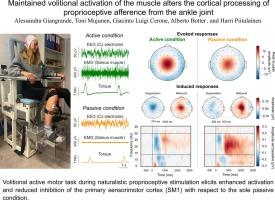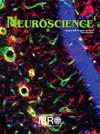Maintained volitional activation of the muscle alters the cortical processing of proprioceptive afference from the ankle joint
IF 2.9
3区 医学
Q2 NEUROSCIENCES
引用次数: 0
Abstract
Cortical proprioceptive processing of intermittent, passive movements can be assessed by extracting evoked and induced electroencephalographic (EEG) responses to somatosensory stimuli. Although the existent prior research on somatosensory stimulations, it remains unknown to what extent ongoing volitional muscle activation modulates the proprioceptive cortical processing of passive ankle-joint rotations.
Twenty-five healthy volunteers (28.8 ± 7 yr, 14 males) underwent a total of 100 right ankle-joint passive rotations (4° dorsiflexions, 4 ± 0.25 s inter-stimulus interval, 30°/s peak angular velocity) evoked by a movement actuator during passive condition with relaxed ankle and active condition with a constant plantarflexion torque of 5 ± 2.5 Nm. Simultaneously, EEG, electromyographic (EMG) and kinematic signals were collected. Spatiotemporal features of evoked and induced EEG responses to the stimuli were extracted to estimate the modulation of the cortical proprioceptive processing between the active and passive conditions.
Proprioceptive stimuli during the active condition elicited robustly ∼26 % larger evoked response and ∼38 % larger beta suppression amplitudes, but ∼42 % weaker beta rebound amplitude over the primary sensorimotor cortex than the passive condition, with no differences in terms of response latencies.
These findings indicate that the active volitional motor task during naturalistic proprioceptive stimulation of the ankle joint enhances related cortical activation and reduces related cortical inhibition with respect to the passive condition. Possible factors explaining these results include mechanisms occurring at several levels of the proprioceptive processing from the peripheral muscle (i.e. mechanical, muscle spindle status, etc.) to the different central (i.e. spinal, sub-cortical and cortical) levels.

肌肉的持续自主激活会改变大脑皮层对来自踝关节的本体感觉的处理。
通过提取对躯体感觉刺激的诱发和诱导脑电图(EEG)反应,可以评估间歇性被动运动的大脑皮层本体感觉处理过程。尽管之前已有关于躯体感觉刺激的研究,但持续的肌肉意志激活在多大程度上调节了被动踝关节旋转的本体感觉皮层处理仍是未知数。25 名健康志愿者(28.8 ± 7 岁,14 名男性)在踝关节放松的被动状态和 5 ± 2.5 牛米恒定跖屈扭矩的主动状态下,接受了运动致动器诱发的总共 100 次右踝关节被动旋转(背屈 4°,刺激间隔 4 ± 0.25 秒,峰值角速度 30°/秒)。同时收集脑电图、肌电图(EMG)和运动学信号。提取脑电图对刺激的诱发和诱导反应的时空特征,以估计主动和被动条件下大脑皮层本体感觉处理的调节情况。与被动条件相比,主动条件下的本体感觉刺激在初级感觉运动皮层引起的诱发反应和β抑制振幅分别增加了26%和38%,但β反弹振幅却减弱了42%,而反应潜伏期则没有差异。这些研究结果表明,与被动状态相比,在对踝关节进行自然本体感觉刺激时,主动的意志运动任务会增强相关的皮层激活,并减少相关的皮层抑制。解释这些结果的可能因素包括从外周肌肉(即机械、肌纺锤状态等)到不同中枢(即脊髓、皮层下和皮层)水平的本体感觉处理的多个层次的机制。
本文章由计算机程序翻译,如有差异,请以英文原文为准。
求助全文
约1分钟内获得全文
求助全文
来源期刊

Neuroscience
医学-神经科学
CiteScore
6.20
自引率
0.00%
发文量
394
审稿时长
52 days
期刊介绍:
Neuroscience publishes papers describing the results of original research on any aspect of the scientific study of the nervous system. Any paper, however short, will be considered for publication provided that it reports significant, new and carefully confirmed findings with full experimental details.
 求助内容:
求助内容: 应助结果提醒方式:
应助结果提醒方式:


